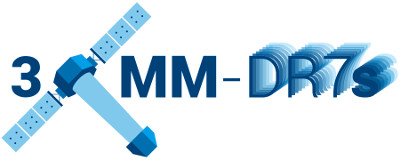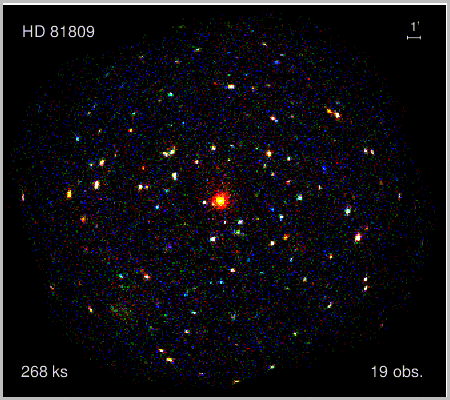



The stacked catalogue 3XMM-DR7s has been compiled from 434 groups, comprising 1 789 overlapping good-quality XMM-Newton observations. They were selected from the public observations taken between 2000 February 3 and 2016 December 15, which were used to generate the catalogue 3XMM-DR7. It contains 71 951 unique sources with positions and source parameters like fluxes in the XMM-Newton standard energy bands, hardness ratios, quality estimate, and information on inter-observation variability. The parameters are directly derived from the simultaneous fit, and, wherever applicable, additionally calculated for each contributing observation. The catalogue aims at exploring the multiply observed sky regions and exploit their survey potential. It thus makes use of the long(er) effective exposure time per sky area and offers the opportunity to investigate long-term flux variability directly through the source detection process. The main catalogue properties are summarised in the table below, the data processing and the stacked source detection are described in the processing summary.
Users of the catalogue are kindly asked to reference the catalogue release paper by Traulsen et al. 2019, A&A 624, A77 (arXiv:1807.09178) in their publications and to include the following policy statement: "This research has made use of data obtained from the 3XMM XMM-Newton serendipitous stacked source catalogue 3XMM-DR7s compiled by the institutes of the XMM-Newton Survey Science Centre selected by ESA."
The catalogue is available for download as a single file in FITS format.
| xmmstack_3XMM_DR7s_v1.1.fits.gz | FITS binary | 199 MB | MD5: 04ef199c60ffb4be2a115f1f7d4b19fb | Full stacked catalogue |
It is also browsable via the web-based interfaces
Please read the Watchouts section before using the catalogues.
A separate file with a summary table of the observations used to compile the stacked catalogue compressed FITS format contains details about the observations from which the 3XMM-DR7s stacked catalogue was compiled. The table and a description of its columns are also provided in HTML format.
| xmmstack_3XMM_DR7s_obslist.fits.gz | FITS binary | 115 KB | MD5: 2182e36733bce95fabe431818ba8c182 | Summary table of observations used in the catalogue |
| 3XMM_DR7s_obslist.html | html | 1.5 MB | MD5: 882e3f6ea5d91985953bdd9212d1d72d | Summary table of observations used in the catalogue |
The following table gives an overview of the properties of the 3XMM-DR7s stacked catalogue.
| Description | Number |
|---|---|
| Number of stacks | 434 |
| Number of observations | 1 789 |
| Time span first to last observation | 2000 Feb 20 – 2016 Apr 02 |
| Approximate sky coverage | 150 sq. deg. |
| Approximate multiply observed sky area | 100 sq. deg. |
| Total number of sources | 71 951 |
| Sources with several contributing observations | 57 665 |
| Sources with flag 0 or 1 | 69 526 |
| Total detection likelihood of at least 10 | 53 492 |
| Extended sources (radius >= 6″) | 3 346 |
| Point sources with VAR_PROB<=1% | 5 607 |
| Point sources with VAR_PROB<= 10–5 | 1 927 |
The median all-EPIC flux in the total energy band 0.2–12 keV of the catalogue sources is 1.89×10–14 erg cm–2 s–1 with median flux error 6.9×10–15 erg cm–2 s–1. About 25% of the sources have all-EPIC fluxes below 10–14 erg cm–2 s–1.
The catalogue contains a column with links to the IRAP catalogue server summary pages for each 3XMM-DR7 association to a unique source from stacked source detection. In the case of sources with multiple detections, the summary page of the best detection is selected (i.e., the detection with the largest exposure time, summed over all cameras), and the summary page gives cross-links to the other detections.
The User
Guide for the 3XMM-DR7 catalogue provides details on how the
observations were processed individually.
New processing steps for the
stacked source catalogue and the newly introduced catalogue columns are
described in the Summary of the stacked
catalogue processing.
Additional information is given in
The stacked catalogue 3XMM-DR7s sources has been cross-matched with a cleaned version of 3XMM-DR7, including all unique sources with at least one contributing detection having a good quality flag 0 or 1. Sources are associated within a matching radius of 2.27 times the sum of their position errors (statistical and systematic errors). Associations sources having large position errors are separated by up to almost 75″. A user-defined maximum separation using the catalogue column DIST_3XMMDR7 can be applied to suppress far offset associations.
The production of the 3XMM catalogues is a collaborative project involving the whole XMM-Newton SSC Consortium:
The SSC team are grateful to the XMM-Newton SOC for their support in the catalogue production activities.
The SSC acknowledges the use of the TOPCAT and STILTS software packages (written by Mark Taylor, University of Bristol) in testing the 3XMM-DR7s stacked catalogue.